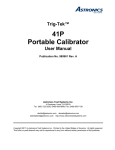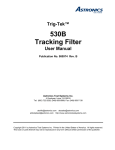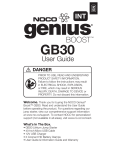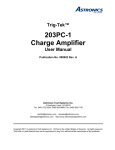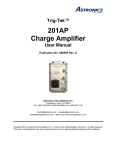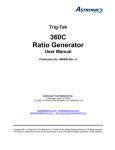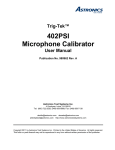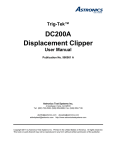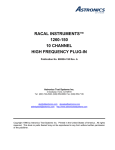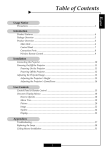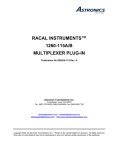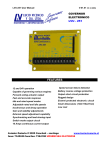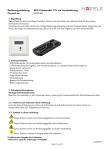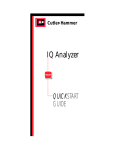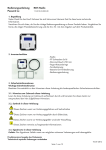Download 6084-084-DM2 1GS/s Digitizer and 6.5
Transcript
Trig-Tek™ 620C Article Protector User Manual Publication No. 981000 Rev. A Astronics Test Systems Inc. 4 Goodyear, Irvine, CA 92618 Tel: (800) 722-2528, (949) 859-8999; Fax: (949) 859-7139 [email protected] [email protected] [email protected] http://www.astronicstestsystems.com Copyright 2014 by Astronics Test Systems Inc. Printed in the United States of America. All rights reserved. This book or parts thereof may not be reproduced in any form without written permission of the publisher. THANK YOU FOR PURCHASING THIS ASTRONICS TEST SYSTEMS PRODUCT For this product, or any other Astronics Test Systems product that incorporates software drivers, you may access our web site to verify and/or download the latest driver versions. The web address for driver downloads is: http://www.astronicstestsystems.com/support/downloads If you have any questions about software driver downloads or our privacy policy, please contact us at: [email protected] WARRANTY STATEMENT All Astronics Test Systems products are designed to exacting standards and manufactured in full compliance to our AS9100 Quality Management System processes. This warranty does not apply to defects resulting from any modification(s) of any product or part without Astronics Test Systems express written consent, or misuse of any product or part. The warranty also does not apply to fuses, software, non-rechargeable batteries, damage from battery leakage, or problems arising from normal wear, such as mechanical relay life, or failure to follow instructions. This warranty is in lieu of all other warranties, expressed or implied, including any implied warranty of merchantability or fitness for a particular use. The remedies provided herein are buyer’s sole and exclusive remedies. For the specific terms of your standard warranty, contact Customer Support. Please have the following information available to facilitate service. 1. Product serial number 2. Product model number 3. Your company and contact information You may contact Customer Support by: E-Mail: Telephone: Fax: [email protected] +1 800 722 3262 (USA) +1 949 859 7139 (USA) RETURN OF PRODUCT Authorization is required from Astronics Test Systems before you send us your product or sub-assembly for service or calibration. Call or contact Customer Support at 1-800-722-3262 or 1-949-859-8999 or via fax at 1-949-859-7139. We can also be reached at: [email protected]. If the original packing material is unavailable, ship the product or sub-assembly in an ESD shielding bag and use appropriate packing materials to surround and protect the product. PROPRIETARY NOTICE This document and the technical data herein disclosed, are proprietary to Astronics Test Systems, and shall not, without express written permission of Astronics Test Systems, be used in whole or in part to solicit quotations from a competitive source or used for manufacture by anyone other than Astronics Test Systems. The information herein has been developed at private expense, and may only be used for operation and maintenance reference purposes or for purposes of engineering evaluation and incorporation into technical specifications and other documents which specify procurement of products from Astronics Test Systems. TRADEMARKS AND SERVICE MARKS All trademarks and service marks used in this document are the property of their respective owners. • Racal Instruments, Talon Instruments, Trig-Tek, ActivATE, Adapt-A-Switch, N-GEN, and PAWS are trademarks of Astronics Test Systems in the United States. DISCLAIMER Buyer acknowledges and agrees that it is responsible for the operation of the goods purchased and should ensure that they are used properly and in accordance with this document and any other instructions provided by Seller. Astronics Test Systems products are not specifically designed, manufactured or intended to be used as parts, assemblies or components in planning, construction, maintenance or operation of a nuclear facility, or in life support or safety critical applications in which the failure of the Astronics Test Systems product could create a situation where personal injury or death could occur. Should Buyer purchase Astronics Test Systems product for such unintended application, Buyer shall indemnify and hold Astronics Test Systems, its officers, employees, subsidiaries, affiliates and distributors harmless against all claims arising out of a claim for personal injury or death associated with such unintended use. FOR YOUR SAFETY Before undertaking any troubleshooting, maintenance or exploratory procedure, read carefully the WARNINGS and CAUTION notices. This equipment contains voltage hazardous to human life and safety, and is capable of inflicting personal injury. If this instrument is to be powered from the AC line (mains) through an autotransformer, ensure the common connector is connected to the neutral (earth pole) of the power supply. Before operating the unit, ensure the conductor (green wire) is connected to the ground (earth) conductor of the power outlet. Do not use a two-conductor extension cord or a three-prong/two-prong adapter. This will defeat the protective feature of the third conductor in the power cord. Maintenance and calibration procedures sometimes call for operation of the unit with power applied and protective covers removed. Read the procedures and heed warnings to avoid “live” circuit points. Before operating this instrument: 1. Ensure the proper fuse is in place for the power source to operate. 2. Ensure all other devices connected to or in proximity to this instrument are properly grounded or connected to the protective third-wire earth ground. If the instrument: - fails to operate satisfactorily shows visible damage has been stored under unfavorable conditions has sustained stress Do not operate until performance is checked by qualified personnel. Publication No. 981000 Rev. A 620C User Manual Table of Contents Chapter 1 .........................................................................................................................1-1 Introduction .....................................................................................................................1-1 Description ..................................................................................................................................... 1-1 Specifications ................................................................................................................................. 1-2 Accel Input .......................................................................................................................... 1-2 Ref Frequency Input ........................................................................................................... 1-2 Compressor Input ............................................................................................................... 1-3 Compressor Output ............................................................................................................ 1-3 Accel Output ....................................................................................................................... 1-3 Velocity Output ................................................................................................................... 1-3 Displacement Output .......................................................................................................... 1-4 Terminals ............................................................................................................................ 1-4 Controls .............................................................................................................................. 1-4 Indicators ............................................................................................................................ 1-5 Dimensions ......................................................................................................................... 1-6 Power Requirement ........................................................................................................... 1-6 Chapter 2 .........................................................................................................................2-1 Operation .........................................................................................................................2-1 Start-Up Procedure ........................................................................................................................ 2-2 Initial Instrument Setup .............................................................................................................. 2-2 Sine Mode .................................................................................................................................. 2-2 Random Mode............................................................................................................................ 2-3 Burst Mode ................................................................................................................................. 2-3 Controls .......................................................................................................................................... 2-3 FAULTS ..................................................................................................................................... 2-3 RESET-START Switch............................................................................................................... 2-4 SHUTDOWN Switch .................................................................................................................. 2-4 MV-pC/g Switch and Sensitivity Thumb Switch ......................................................................... 2-4 CURR-mV- pC Switch (Rear Panel) .......................................................................................... 2-4 SE-ISO-DIFF Switch (Rear Panel) ............................................................................................. 2-4 ACCEL g’s Switch and GAIN SET LEVEL Thumb Switch ........................................................ 2-5 OVERTEST and UNDERTEST dB Set Switches ...................................................................... 2-5 SET (Displacement) OVERTRAVEL Thumb Switch .................................................................. 2-5 SINE-BURST-RANDOM Switch ................................................................................................ 2-5 Chapter 3 .........................................................................................................................3-1 Performance Test ............................................................................................................3-1 Astronics Test Systems i 620C User Manual Publication No. 981000 Rev. A Test Equipment ...............................................................................................................................3-1 Switch Settings ...............................................................................................................................3-1 Performance Procedure ..................................................................................................................3-1 Chapter 4 ........................................................................................................................ 4-1 Calibration Procedure .................................................................................................... 4-1 Test Equipment ...............................................................................................................................4-1 Instrument Setup.............................................................................................................................4-1 Switch Settings ...............................................................................................................................4-1 Charge Amplifier Adjustment ..........................................................................................................4-2 Velocity and Displacement Adjustments ........................................................................................4-2 Deviation Meter Adjustments ..........................................................................................................4-3 ii Astronics Test Systems Publication No. 981000 Rev. A 620C User Manual List of Figures Figure 1-1, 620C Front View .............................................................................................................. 1-1 Figure 1-2, 620C Rear View............................................................................................................... 1-2 Figure 2-1, Simplified System Block Diagram................................................................................... 2-1 Figure 4-1, Main Board Variable Resistor Locations ........................................................................ 4-2 Figure 4-2, A3 Board Resistor Locations .......................................................................................... 4-2 Astronics Test Systems iii 620C User Manual Publication No. 981000 Rev. A This page was left intentionally blank. iv Astronics Test Systems Publication No. 981000 Rev. A 620C User Manual List of Tables Table 2-1, Sine 3dB Overtest ............................................................................................................ 2-3 Table 2-2, Random (White Noise) .................................................................................................... 2-4 Astronics Test Systems v 620C User Manual Publication No. 981000 Rev. A DOCUMENT CHANGE HISTORY vi Revision Date A 1/16/2014 Description of Change Document Control release Astronics Test Systems Publication No. 981000 Rev. A 620C User Manual Chapter 1 Introduction The Trig-Tek™ 620C Article Protector (Figures 1-1 and 1-2) monitors the feedback from an accelerometer on a shaker, and provides rapid shutdown when preset limits for acceleration overtest, undertest, displacement overtravel, signal loss, or power interrupt is encountered. The shutdown is accomplished by an independent compressor circuit which provides a controlled shutdown. The time required for shutdown is the total of the detection time plus the compression time. When in the SINE mode, the detection time is varied by the excitation frequency. It is approximately 100 milliseconds at 20 Hz and changes to about 5 milliseconds at 2000 Hz. Time after detection to full compression is about 3 milliseconds. When in the RANDOM mode, the detection time is preset for 330 milliseconds. The ACCEL input is Dual mode and will also operate with Differential accelerometers. Figure 1-1, 620C Front View Description A built-in dual mode charge amplifier accommodates accelerometers with 0.1 to 120 pC-mV/g sensitivities, and also differential accelerometers. A built-in current source with an ON-OFF switch provides power to accelerometers with built-in electronics. An mV/g input can be used with the current OFF. The normalized acceleration signal is integrated to velocity and again to displacement, and the three parameters: Acceleration, Velocity, and Displacement are simultaneously brought out as normalized AC signals. A SINE-RANDOM switch selects RMS units at the INPUT for the RANDOM position, and PEAK units for the SINE position. The acceleration test level is set by a MULTIPLIER and DECADE switch for levels between 0.1 to 100 g’s. Once the test level is set, the OVERTEST +dB set and UNDERTEST –dB set switches can be set in any of six settings from 1 dB to 6 dB independently. In the Sine mode, a separate DISPLACEMENT OVERTRAVEL is provided that is responding to the Pk-Pk Displacement with up to 2990 MILS in 10MIL steps. A DEVIATION meter provides a monitor to verify the test settings and observe the +/- deviation from the set position. Loss of signal detection is Astronics Test Systems Introduction 1-1 620C User Manual Publication No. 981000 Rev. A provided during the start-up mode, and when the –1dB REF point is passed, the unit switches to the OPERATE mode. If there is no feedback to the controller, the detector will do a controlled shutdown when the OVERTEST setting is reached. Figure 1-2, 620C Rear View Specifications Accel Input Level (pC accel) (mV accel) Frequency Impedance Range 2 Hz to 10 kHz (pC accel) (mV accel) (Differential) Connectors 0.1 pC/g to 120 pC/g. 0.1 mV/g to 120 mV/g Greater than 10 meg Ohms Greater than 100 k Ohms. Constant current source for accelerometers with built-in charge converter (with ON-OFF switch) Greater than 10 meg Ohms Microdot and BNC for pC and mV, and three-pin for differential accelerometers Ref Frequency Input Level 0.1 to 20 V RMS Impedance Greater than 250 k Ohms Frequency Range 2 Hz to 10 kHz Wave Form Any recurring waveform Connector BNC (isolated) Introduction 1-2 Astronics Test Systems Publication No. 981000 Rev. A 620C User Manual Compressor Input Level 0 to 10 V RMS (Sine). 0 to 2 V RMS (Random) Impedance 100 k Ohms Gain BNC (isolated) Compressor Output Level 0 to 10 V RMS (Sine). 0 to 2 V RMS (Random) Impedance Less than 50 Ohms (5 mA max) Gain 0 dB ±1 dB (ZERO compression). -80 dB (FULL compression) Level Sine: 0 to 10V RMS Random: 0 to 2V RMS Sensitivity 10 mV /g Impedance 50 Ohms (5 mA max) Frequency Range 2 Hz to 10 kHz Amplitude vs. Frequency ±3% of reading ±0.5% FS Dynamic Range 70 dB (minimum) Connector BNC (isolated) Accel Output Velocity Output Level Sine: 0 to 10V RMS Random: 0 to 2V RMS Sensitivity 10 mV/IPS Impedance 50 Ohms (5 mA max) Frequency Range 5 Hz to 2000 Hz Frequency Response Follow a 6 dB/octave slope. 10 Hz to 1,000 Hz ±3% of reading ±1% FS 5 Hz to 2000 Hz ±5% of reading ±1% FS Astronics Test Systems Introduction 1-3 620C User Manual Publication No. 981000 Rev. A Dynamic Range 50 dB (minimum) Connector BNC (isolated) Displacement Output Level 0 to 3 V RMS (RANDOM) Sensitivity .707 V/in. Impedance 50 Ohms (5 mA max) Frequency Range 5 Hz to 2,000 Hz Frequency Response Follows a 12 dB/octave slope. 10 Hz to 500 Hz ±4% of reading ±1% of FS 5 to 1000 Hz ±5% of reading ±1% of FS. Dynamic Range 40 dB (minimum) Connector BNC (isolated) Shutdown NORMAL Relay NO-COM-NC contacts, relay energizes when any set-in limit is exceeded, it remains energized until the condition is RESET. Shutdown DELAY Relay NO-COM-NC contacts, relay energizes approximately 500 milliseconds after the shutdown relay. It remains energized until the condition is RESET. RESET-START Normally Terminal at GND opens to RESET. Shut down Normally Terminal at GND opens to SHUT DOWN. BYPASS Normally Terminal at GND opens to BYPASS. POWER Switch Turns power ON. INPUT Switch (RP) Selects either pC/g, mV/g or mV/g CURR. Terminals Controls Introduction 1-4 Astronics Test Systems Publication No. 981000 Rev. A 620C User Manual Sensitivity Switch Selects 0.1-1.2, 1-12, or 10-120 multiplier for the sensitivity thumb switch. Sensitivity Thumb Switch Four decade thumb switch sets the acceleration gain to accommodate the particular pickup being used. Switch covers 1 to 12 range and works in conjunction with the sensitivity multiplier switch to cover the range of 0.1-120 pC/g. SE-ISO-DIFF Switch (RP) Provides isolated or single-ended operation for pC, SE for pC/g, and DIFF for differential pickups. SINE-RANDOM Burst Switch Selects RMS units at the input when in the RANDOM position and PEAK units when in the SINE position. OVERTEST +dB Set Thumb Switch A six-position switch to set 1, 2, 3, 4, 5, or 6 dB, and 0 is OFF. UNDERTEST –dB Set Thumb Switch A six-position switch to set 1, 2, 3, 4, 5, or 6 dB, and 0 is OFF. If ON, it will initiate when the -1dB point is passed. TEST LEVEL Set Thumb Pot Used in conjunction with the ACCEL g’s Switch. Calibrated from 1 to 12. ACCEL g’s Switch Selects .1-1.99, 1-19.9, or 10-199 as the switch multiplier for the TEST LEVEL set thumb pot. OPER(Operate)-BYPASS OPER position is for normal operation. The BYPASS position connects the compressor input to the compressor output jack. RESET-START Switch When mometarily pressed, the RESET switch resets any fault condition (if the original Fault is removed) and sets up the START condition. SET (Displacement) OVERTRAVEL (Thumb Switch) Provides adjustment from 0.300 to 2.999 MILS for the displacement overtravel set points. 0000 disables the DISPLACEMENT OVERTRAVEL. START UP OFF ON Switch Provides a way to disable the REF input as part of the start-up sequence Deviation/Level Set Meter 3-1/2 digit digital voltmeter to display the monitor input level. Indicators Astronics Test Systems Introduction 1-5 620C User Manual Publication No. 981000 Rev. A Feedback LED Normally illunimates green. If Feedback signal is not detected in the start time interval, the LED turns red and indicates a fault. SIG Loss Illuminates (RED), turns GRN if FEEDBACK is detected before timer expires. Oper LED Illuminates (RED) and turns GRN when the g level reaches 90%. Under Test LED Illuminates (RED) when the –dB SET setting is exceeded. It remains lit until the RESET-START switch is depressed. Over Test LED Illuminates (RED) when the +dB SET setting is exceeded. It remains lit until the RESET-START switch is pressed. Displ (Displacement) OV (Over) Travel LED Illuminates (RED) when the overtest set level has been exceeded. It remains lit until the RESET-START switch is pressed. (Setting “0000” on the SET OVERTRAVEL thumb switch disables the function.) Bypass LED Illuminates (RED) when BYPASS on the OPER-BYPASS switch is selected. Power Interupt LED Illuminates (RED) if the Power is interrupted. It stays lit until the RESETSTART switch is pressed. Fault LED Illuminates (RED) if any fault occurs or if a signal is present at the compressor input when the RESET-START button is pressed. Dimensions 3-1/2 inches high, 9 inches deep, 19 inches wide Power Requirement 90 to 230 V RMS, 50 to 400 Hz, approx 25 W Introduction 1-6 Astronics Test Systems Publication No. 981000 Rev. A 620C User Manual Chapter 2 Operation The 620C Article Protector is designed to provide a means of monitoring a Vibration Test System, using a controlled vibration exciter. This device’s purpose is to protect the test article and the shaker. The unit monitors the level of vibration in both the Displacement and Acceleration parameters, and does an automatic shutdown should any of the preset limits be exceeded. This chapter provides a start-up sequence and then describes each control and provides a method to best achieve the means of protection for the device being monitored. A simplified system block diagram is shown in Figure 2-1. Figure 2-1, Simplified System Block Diagram Astronics Test Systems Operation 2-1 620C User Manual Publication No. 981000 Rev. A Start-Up Procedure Refer to Figures 1-1 and 1-2 for the location of the various switches, controls, and indicators. Initial Instrument Setup When a test is ready and all the instruments are ON, the 620C RESET-START push button switch should be depressed. This resets any fault and places the unit in the start-up condition. CAUTION If the REF input is not used, set the START UP switch (on the rear panel) to OFF. NOTE Before RESET the ACCEL and REF inputs must be zero (no signal). Sine Mode When the RESET-START switch is depressed, all LEDs should be GREEN except the OPER LED which will be RED. The start-up sequence will go through the following steps. 1. The SET (Displacement) OVERTRAVEL, UNDERTEST, and OVERTEST should be set as appropriate for the test. (To turn off the OVERTRAVEL, set switch to 0000.) 2. If the INPUT signal doesn’t pass the -30 dB detector (after the REF input is detected), the FEEDBACK LED will turn RED and the FAULT LED illuminates and shuts the test down. 3. When the INPUT level passes the -1 dB detector, the OPER LED turns GREEN and the LEVEL holds at the 0 dB point. If it doesn’t hold 0 dB, when the OVERTEST SET LEVEL is reached, the OVERTEST and FAULT LED turns RED and shuts the test down – indicating the wrong set g LEVEL or CONTROLLER setting. 4. When the OPER LED turns GREEN the DEVIATION meter should be at “0” deviation and all LEDs green. Minor adjustment of the ACCEL g’s control may be needed to set a “0” deviation. 5. The UNDERTEST and SIGNAL LOSS is armed when the OPER LED is GREEN. 6. The SIGNAL LOSS and FAULT LEDs turn RED if the INPUT signal goes below -30 dB. Operation 2-2 Astronics Test Systems Publication No. 981000 Rev. A 620C User Manual Random Mode 1. When the RESET-START is depressed, all LEDs except the OPER are GREEN. 2. When the FEEDBACK passes the -1 dB detection the OPER LED turns GREEN. This arms UNDERTEST and SIGNAL LOSS detection. 3. The DISPL OVERTRAVEL is OFF. 4. When a fault occurs, the detected fault and the FAULT LED turns RED, and the COMPRESSOR Shutdown and the SHUTDOWN relays are activated. Burst Mode 1. When the FAULT-RESET is depressed, all LEDs are GREEN. 2. The UNDERTEST, SIGNAL LOSS, and DISPL OVERTRAVEL are OFF. 3. The OVERTEST is active. 4. When an OVERTEST FAULT occurs, the OVERTEST and FAULT LEDs turn RED and shutdown occurs. Controls FAULTS When any of the preset limits are exceeded, the FAULT LED will blink RED and the system will shut down (go to FULL compression). Also the SHUTDOWN relays will energize. The time required to shutdown when a FAULT occurs is comprised of two parts, the detection time and the compressor attenuation time. The compressor attenuation time is fixed at three milliseconds. The detection time is controlled by frequency when in the SINE mode, and is fixed when in the random mode. Both the amount the limit is exceeded by, and the frequency will affect the shutdown time. Table 2-1 shows the shutdown time for overtest dB and frequencies of 5, 50, 100, 500, 1K and 5K. Table 2-2 shows the Random Shutdown times. Table 2-1, Sine 3dB Overtest Astronics Test Systems Frequency (Hz) Shutdown Time (mS) 5 110 10 60 50 40 100 25 500 20 1000 20 5000 20 Operation 2-3 620C User Manual Publication No. 981000 Rev. A Table 2-2, Random (White Noise) Overtest (dB) Shutdown Time (mS) 1 60 3 250 6 1200 NOTE: All FAULTS must be removed before RESET. The ACCEL and Compressor inputs must be ZERO. RESET-START Switch This is a push button switch – when pressed, it resets any fault and sets the unit for start-up mode. SHUTDOWN Switch This is a push button switch that shuts the system down in 3 milliseconds after being mometarily pressed. When the unit is turned on the switch should be tested to assure it is working. The FAULT LED should remain illuminated until reset. MV-pC/g Switch and Sensitivity Thumb Switch MV-pC/g Switch selects the sensitivity range of the Input sensor. The Sensitivity thumb switch sets the sensitivity in that range. CURR-mV- pC Switch (Rear Panel) The CURR-mV- pC switch provides a means of selecting pC or mV operation of the charge amplifier. The mV-CURR position turns the Current ON to operate integrated sensors. When this switch is placed in the pC position, the charge amplifier is configured to accept a charge input from a standard accelerometer with a picocoulomb output. The mV position provides the ability to use mV/g signals with no current at the input SE-ISO-DIFF Switch (Rear Panel) When the pC Input is selected by the CURR-mV- pC Switch, the charge amplifier input can be operated either in the SE (single-ended) mode, or in the ISO (isolated) mode. When in the ISO mode, the picocoulomb input to the charge amplifier is floating and is isolated from both chassis and signal ground. This position will be used when the pickup is grounded at the mounting point. If the pickup is not grounded, the SE position of the switch should be selected. When mV/g is selected the input is always SE. In the DIFF position the PC position of the CURR-mV- pC is selected and the input is via the three-pin connector, as the plus and minus inputs are being driven. Operation 2-4 Astronics Test Systems Publication No. 981000 Rev. A 620C User Manual ACCEL g’s Switch and GAIN SET LEVEL Thumb Switch The GAIN SET Level Switch works in conjunction with the ACCEL g’s switch to provide a means to set from .1 to 200 g’s as the SET LEVEL. Set these switches for the g level that the test is to be run at. OVERTEST and UNDERTEST dB Set Switches Each of the switches have six positions to select 1 to 6dB as the OVERTEST or UNDERTEST level. The ZERO position turns the function OFF. The switch should be placed to the appropriate position as determined by the conditions of the test being run. SET (Displacement) OVERTRAVEL Thumb Switch The SET OVERTRAVEL monitors the displacement at the protector input. This SET OVERTRAVEL switch provides settings from 300 to 2990 MILS P-P. It should be set to a displacement below the travel of the shaker. In the Random and Burst modes, the OVERTRAVEL is disabled. SINE-BURST-RANDOM Switch This instrument is designed to monitor and protect test systems that are being subjected either to SINE, BURST, or RANDOM excitation. When the input to the unit is a sine wave, the switch should be in the SINE position. When Random excitation is being used, placing this switch to RANDOM configures the system to a fixed shutdown detection time of approximately 330 milliseconds. For a sine burst waveform, place the switch to BURST position. Tables 2-2 and 2-3 list some of the shutdown times as they related to the overtest level and frequency. The last line shows the timing for random noise, when the SINE-BURST-RANDOM switch is placed to RANDOM Astronics Test Systems Operation 2-5 620C User Manual Publication No. 981000 Rev. A This page was left intentionally blank. Operation 2-6 Astronics Test Systems Publication No. 981000 Rev. A 620C User Manual Chapter 3 Performance Test The procedure in this chapter provides a method of testing the 620C Article Protector for compliance to manufacturer specifications. In the event that a reading is out of tolerance the unit may require calibration (see Chapter 4). The unit should operate for more than 12 months without maintenance unless a component fails. Test Equipment Note: Equivalent equipment can be used. Function Generator Trig-Tek 346B AC-DC Digital Voltmeter Keithley 191 Switch Settings Note: Refer to Figures 1-2 and 1-3 for switch and connector locations. Place these switches in the following settings: • mV-pC/g switch to 1-12 • SENSITIVITY switch to 10.00 • ACCEL g’s switch to 10-120 • SET LEVEL switch to 100.0 • SE-ISO-DIFF switch (RP) to SE • PC mV-CURR switch (RP) to mV • SINE-BURST-RANDOM switch to SINE • OPER-BYPASS switch to OPER • POWER switch to ON Performance Procedure 1. Connect the signal generator to the ACCEL INPUT jack. Set the generator for 61.4 ±0.2 Hz and 100.0 ±0.5 millivolts RMS. 2. Connect the AC Voltmeter to ACCEL AC OUTPUTS jack. 3. Observe an indication of 100 ±3 millivolts RMS on the AC Voltmeter. Astronics Test Systems Performance Test 3-1 620C User Manual Publication No. 981000 Rev. A 4. Place the SENSITIVITY thumb switch to 01.00. 5. Observe an indication of 1000 ±30 millivolts RMS on the AC Voltmeter. 6. Connect the AC Voltmeter to the VELOCITY AC OUTPUTS jack. 7. Observe an indication of 1000 ±50 millivolts RMS on the AC voltmeter. 8. Change the generator frequency to 44.3 ±0.2 Hz. 9. Connect the AC Voltmeter to the DISPL AC OUTPUTS jack. 10. Observe an indication of 1000 ±50 millivolts RMS on the AC Voltmeter. 11. Return the SENSITIVITY switch to 10.00. 12. Set the generator frequency to 140 Hz and the level to 707 ±5 millivolts RMS. 13. Observe an indication of 0 ±0.25 dB on the DEVIATION meter. 14. Change the generator level to 1.41 V RMS. 15. Observe an indication of +6dB ±0.25 dB on the DEVIATION meter. Performance Test 3-2 Astronics Test Systems Publication No. 981000 Rev. A 620C User Manual Chapter 4 Calibration Procedure The 620C Article Protector’s circuitry is packaged on a single circuit board. The adjustments are all accessible from the top when the instrument cover is removed. The locations of the various adjustments are marked on the PC board. The following procedure provides the method to make the adjustments. Test Equipment Note: Equivalent equipment can be used. Function Generator Voltage-to-Charge Converter AC-DC Digital Voltmeter Trig-Tek 45EMD Calibrator Trig-Tek 2030 Keithley 191 Instrument Setup Remove the top cover of the unit and connect the power cord to AC power between 90 and 230 Volts RMS. Switch Settings Note: Refer to Figures 1-2 and 1-3 for switch and connector locations. Refer to Figures 4-1 and 4-2 for variable resistor locations on the main motherboard and A3 daughter board. Place these switches in the following settings: • mV-pC/g switch to 1-12 • SENSITIVITY switch to 10.00 • ACCEL g’s switch to 10-120 • SET LEVEL switch to 100.0 • SE-ISO-DIFF switch (rear panel) to ISO • PC mV-CURR switch (real panel) to PC • SINE-BURST-RANDOM switch to SINE Astronics Test Systems Calibration Procedure 4-1 620C User Manual Publication No. 981000 Rev. A Figure 4-1, Main Board Variable Resistor Locations Charge Amplifier Adjustment 1. Connect the signal generator to the ACCEL INPUT jack. 2. Set the rear panel SE-ISO-DIFF switch to SE, and the CURR-mV-pc switch to mV. 3. Set the generator for approximately 500 Hz and 707 ±4 millivolts RMS. 4. Connect the AC Voltmeter to the ACCEL AC OUTPUT jack. 5. Set the ACCEL FS ADJ R1 (Figure 4-1) for 707 ±5 mV RMS on the AC Voltmeter. Velocity and Displacement Adjustments Figure 4-2, A3 Board Resistor Locations Calibration Procedure 4-2 Astronics Test Systems Publication No. 981000 Rev. A 620C User Manual 1. Set the generator at the ACCEL INPUT for 61.4 ±0.1 Hz and 707 ±4 millivolts RMS. 2. Connect the AC Voltmeter to the VEL (Velocity) AC OUTPUT jack. 3. Set the VELOCITY ADJ R1 (Figure 4-2) on the A3 W34A Integrator Module, for a 1000 ±5 mV RMS indication on the AC Voltmeter. 4. Connect the AC Voltmeter to DISPL AC OUTPUT jack. 5. Set the generator frequency for 44.3 ±0.1 Hz. 6. Set the DISPL ADJ R2 (Figure 4-2) on A3 for a 707 ±5 millivolts RMS indication on the AC Voltmeter. Deviation Meter Adjustments 1. Return the AC meter to the ACCEL AC OUTPUTS jack. 2. Set the generator at the ACCEL INPUT for approximately 500 Hz and 707 ±4 millivolts RMS. 3. Set the dB ADJ R2 (Figure 4-1) for a 0.0 ±0.1 dB indication on the DEVIATION Meter. 4. Change the generator level to 1414 ±10 millivolts RMS. 5. Adjust the DEV GAIN ADJ R3 (Figure 4-1) for a +6 ±0.1 dB indication on the DEVIATION Meter. 6. Change the generator level to 1000 ±10 millivolts RMS. 7. Move SINE-BURST-RANDOM switch on the front of the 620C to RANDOM. 8. The DEVIATION Meter on the front panel should show 0 ±0.2dB. Astronics Test Systems Calibration Procedure 4-3 620C User Manual Publication No. 981000 Rev. A This page was left intentionally blank. Calibration Procedure 4-4 Astronics Test Systems




























